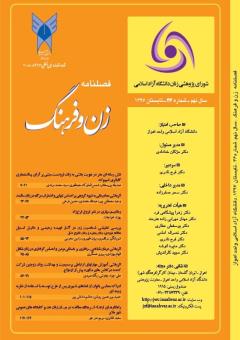نقش رسانهای هنر در هویت بخشی به زنان فرودست مبتنی بر آرای پسااستعماری گایاتری اسپیوک
محورهای موضوعی : جامعه شناسیصدیقه پورمختار 1 , شمس الملوک مصطفوی 2 * , سیدمحمد مرندی 3
1 - دانشگاه آزاد اسلامی واحد علوم و تحقیقات تهران، گروه فلسفه هنر، تهران، ایران.
2 - دانشگاه آزاد اسلامی واحد علوم و تحقیقات تهران، گروه فلسفه هنر، تهران، ایران.
3 - دانشگاه تهران، گروه زبان و ادبیات انگلیسی، تهران، ایران.
کلید واژه: گایاتری اسپیوک, هنر, هویت, زنان فرودست,
چکیده مقاله :
پژوهش حاضر با هدف یافتن راهی برای هویت بخشی به زنان فرودست به بررسی و تحلیل دیدگاه های گایاتری چاکراورتی اسپیوک، از منتقدان و متفکران حوزه ی مطالعات پسااستعماری می پردازد. او در مقاله ی معروف خود" آیا فرودستان می توانند سخن بگویند؟"، به بررسی وضعیت فرودستان می پردازد و با توجه به عواملی چون نفوذ استعمار و مردسالاری به این نتیجه می رسد که فرودستان نمی توانند سخن بگویند. او با توجه به نقدهای فمینیسم، مارکسیسم و مطالعات فرودستان می گوید که سلسله مراتب اجتماعی- سیاسی استعماری در حیطه ی پسااستعماری بازتولید شده اند، و صدای فرودستان هیچ گاه شنیده نمی شود. این مقاله با روش توصیفی – تحلیلی به نقد آرای اسپیوک می پردازد و به دنبال راهکاری برای هویت بخشی به زنان فرودست است. یافته های پژوهش نشان می دهد که اسپیوک تنها به وجه کلامی ارتباط توجه کرده و وجه غیرکلامی ارتباط که هنر از پایه های اصلی آن است را مورد بی اعتنایی قرار داده است. هنر در نقش یک رسانه می تواند به مثابه زبان فرودستان عمل کند و به آنان هویت ببخشد. فعالیت هنری زنان ایران در جزیره ی هرمز نمونه ای از این کارکرد رسانه ای هنر است که توانسته است به آنان هویت ببخشد.
The present study aims were to find a way to identity formation of the subaltern women via reviewing and analyzing the ideas of Gayatri Chakravorty Spivak one of the critics and thinkers of the post-colonial studies. In her famous article, "Can the Subaltern Speak?" she examined the status of the subalterns and, considering colonialism and patriarchy, found that the subalterns could not speak out. According to her critique of feminism, Marxism, and subaltern studies, she believed that the colonial social-political hierarchy has been reproduced in the post-colonial domain, and the voice of the subalterns was never heard. This research criticized Spivak's ideas with a descriptive-analytical method and sought an approach to identity formation of the subaltern women and answer the question that how the subaltern woman could speak out? The findings of the research showed that Spivak only focused on verbal communication and disregards the non-verbal aspect of it; which art could be its main pillar. Art in the role of a media could act as a language for subalterns and give them identity. The artistic activities of Iranian women on the Hormuz Island were an example of such a media that had been able to give them identity.
- دادگران، محمد. (1387). مبانی ارتباطات جمعی. چاپ یازدهم. تهران: مروارید.
- حقیقی، مانی. (1389). سرگشتگی نشانهها. چاپ ششم. تهران: مرکز.
- شاهمیری، آزاده. (1389). نظریه و نقد پسااستعماری. تهران: علم
- نادعلیان، احمد. (1396). احمد نادعلیان. تهران: احمدنادعلیان.
- نجومیان، امیرعلی؛ ذوالفقاری، غلامعباس. (1389).درآمدی بر مطالعات فرودستان. فصلنامه علمی پژوهشی تاریخ، 5 (17). محلات: دانشگاه آزاد اسلامی واحد محلات.
- Christin, A. M. ie. (2001). A History of Writing: From Hieroglyph to Multimedia. Paris: Flammarion.
- Feldman, E. (1981). Art is for Reading: Pictures Make a Difference. Teachers College Record, 82 (4), 649-656.
- Feldman, E. (1976). Visual Literacy. Journal of Aesthetic Education, 0(3/4), 191-200.
- Feldman, E. (1981) Art Criticism and Reading. Journal of Aesthetic Education, 15 (4), 75-95.
- Guha, R.(1997). A Subaltern Studies Reader. Minnesota: University of Minnesota Press.
- Gramsci, A. (1971). Selections From the Prison Notebooks. trans:Noell Smith. New York: International Publishers.
- Hornby, A.S. (2000). Oxford Advanced Learner`s Dictionary. Oxford: Oxford University Press.
- Hunt, J. D. (2010). Introduction to Art, Wordand Image: Two Thousand Years of Visual/TextualInteraction. London: Reaktion.
- Kepes, G. (1994). Language of Vision. Chicago: Paul Theobald.
- Lahey, M. (1988). Language Disorders and Language Development, New York: MacMillan
- Margolis, J. (1995). The Language of Art and Art Criticism. Detroit: Wayne State University Press.
- Morton, S. (2003). Gayatri Chakrovorty Spivak. London: Routledge.
- Prakash, G. (1994). "Subaltern Studies as Postcolonial Criticism", The American Historical Review. Vol. 99, No. 5, 1475–1490.
- Ross, L. (2014). Language in the Visual Arts. Carolina:McFarland & Company.
- Sanders, M. (2006). Gayatry Chakrovorty Spivak: Live Theory. New York: Continuum.
- Sharp, J. (2009). Geographies of Postcolonialism. New York: Sage.
- Spivak, G. Ch. (1985). "Three Texts of three women and a critique of Imperialism".Critical Inquiry (xii) Autumn,pp.243-61.
- Spivak, G. Ch. (1990). The Post- Colonial Critic. New York: Routledge.
- Spivak, G. Ch. (1995). The Spivak Reader. (L. Donna, & M. Gerald, Eds.) New York: Routledge.
- Spivak, G. Ch. (1999). A Critique on Postcolonial Reason Towards a History of Vanishing Present. Massachusette: Harvard University Press.
- Spivak, G. Ch. (2007). Who Sings the Nation- State? New York: Seagull Books.
- Spivak, G. Ch. (1987). In Other Worlds Essays in Cultural Politics.
- Spivak, G. Ch. (1988). Can the Subaltern speak?. Basingstok: Macmillan.
- Slemon, S. (1987) ‘Monuments of empire: allegory/counter-discourse/ post-colonial writing’, Kunapipi (9) 3: 1–16.
- Young, R, J.C. (2003). Postcolonialism: A Very Short Introduction. Oxford: Oxford University Press. URL: www.artriver.net
_||_

